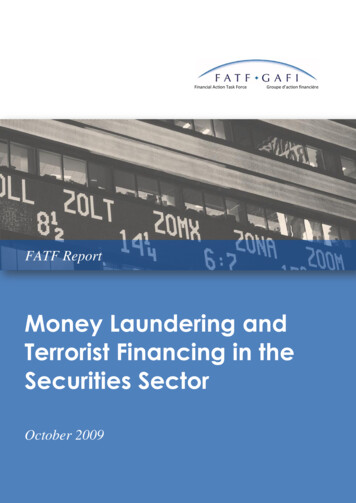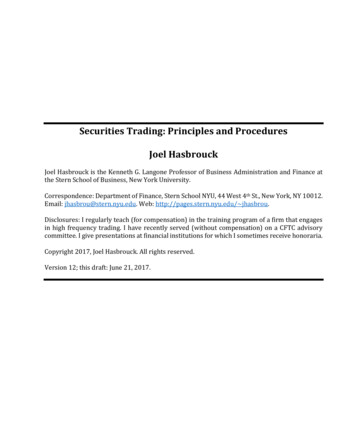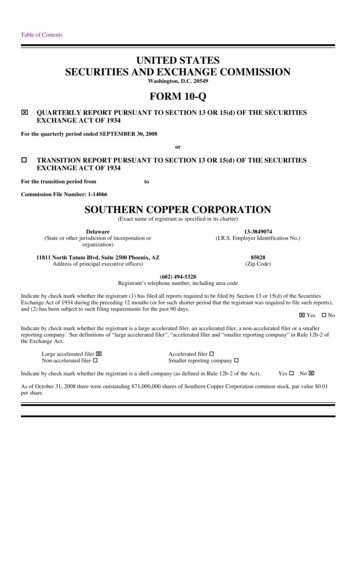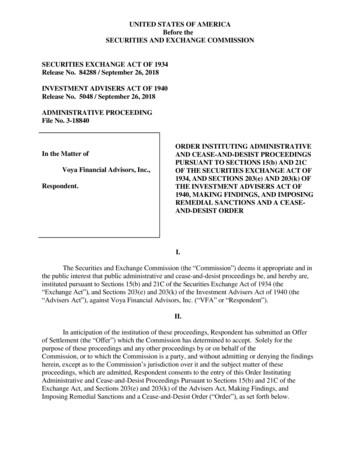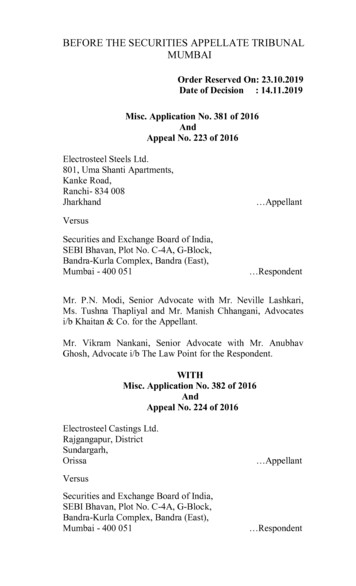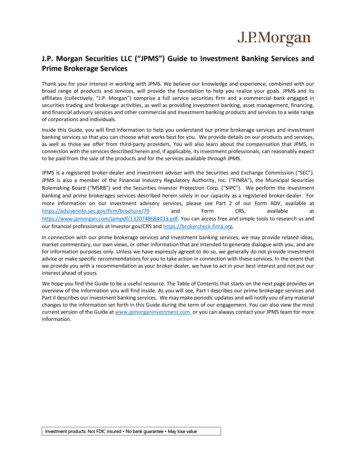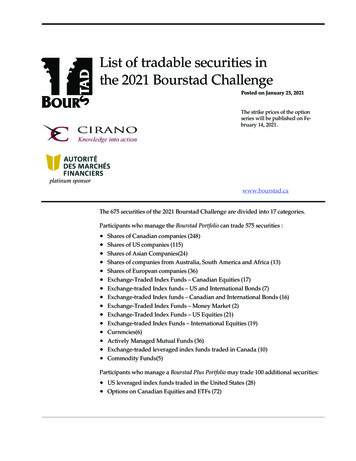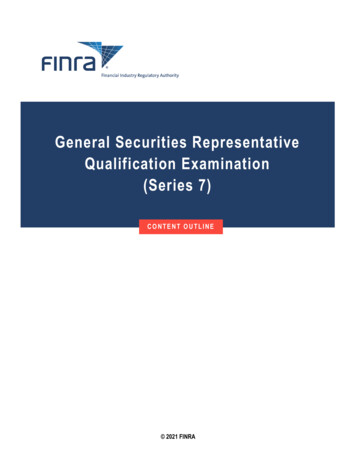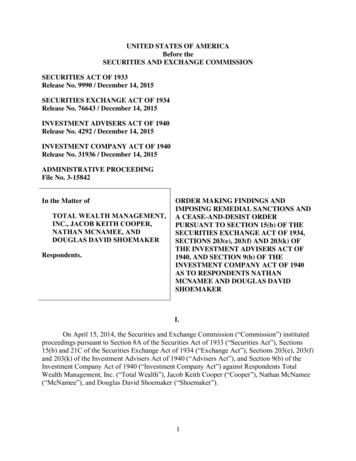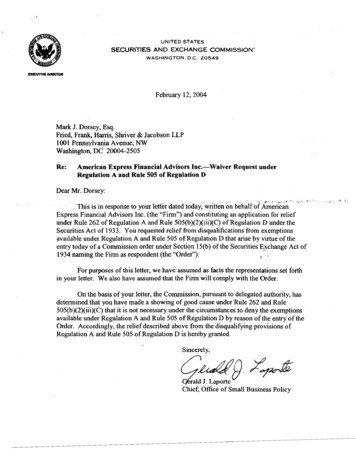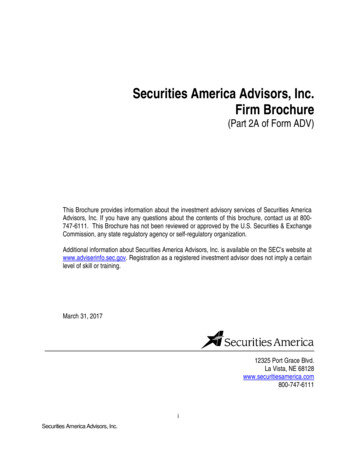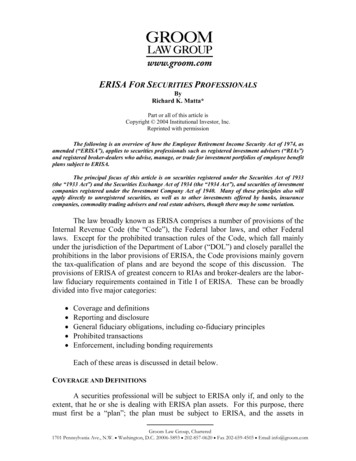
Transcription
ERISA FOR SECURITIES PROFESSIONALSByRichard K. Matta*Part or all of this article isCopyright 2004 Institutional Investor, Inc.Reprinted with permissionThe following is an overview of how the Employee Retirement Income Security Act of 1974, asamended (“ERISA”), applies to securities professionals such as registered investment advisers (“RIAs”)and registered broker-dealers who advise, manage, or trade for investment portfolios of employee benefitplans subject to ERISA.The principal focus of this article is on securities registered under the Securities Act of 1933(the “1933 Act”) and the Securities Exchange Act of 1934 (the “1934 Act”), and securities of investmentcompanies registered under the Investment Company Act of 1940. Many of these principles also willapply directly to unregistered securities, as well as to other investments offered by banks, insurancecompanies, commodity trading advisers and real estate advisers, though there may be some variation.The law broadly known as ERISA comprises a number of provisions of theInternal Revenue Code (the “Code”), the Federal labor laws, and other Federallaws. Except for the prohibited transaction rules of the Code, which fall mainlyunder the jurisdiction of the Department of Labor (“DOL”) and closely parallel theprohibitions in the labor provisions of ERISA, the Code provisions mainly governthe tax-qualification of plans and are beyond the scope of this discussion. Theprovisions of ERISA of greatest concern to RIAs and broker-dealers are the laborlaw fiduciary requirements contained in Title I of ERISA. These can be broadlydivided into five major categories: Coverage and definitionsReporting and disclosureGeneral fiduciary obligations, including co-fiduciary principlesProhibited transactionsEnforcement, including bonding requirementsEach of these areas is discussed in detail below.COVERAGE AND DEFINITIONSA securities professional will be subject to ERISA only if, and only to theextent, that he or she is dealing with ERISA plan assets. For this purpose, theremust first be a “plan”; the plan must be subject to ERISA, and the assets inGroom Law Group, Chartered1701 Pennsylvania Ave., N.W. Washington, D.C. 20006-5893 202-857-0620 Fax 202-659-4503 Email info@groom.com
-2question must be “plan assets” of that plan. Once this determination is made, thenext question usually is whether the RIA or broker-dealer is an ERISA “fiduciary”or merely a non-fiduciary service provider to the plan.What Is an ERISA Plan?The requirements of ERISA Title I only apply to “employee benefit plans,”or simply “plans,” which are further subdivided into “pension plans” and “welfareplans.” At minimum, every ERISA plan requires: A “plan.” Certain ad hoc arrangements, for one or two individualemployees usually are not plans. A plan sponsor. Specifically, there must be more than de minimisinvolvement of an employer or union sponsor – hence most 403(b) taxsheltered annuities are sold directly to employees and are outside ofERISA. Employees. A plan must cover employees; accordingly, a plan coveringonly self-employed individuals and their spouses is not subject to ERISA. Employee benefits. Although not normally at issue, some common payrollpractices and employee “perks” are not employee benefits for ERISApurposes.For lack of an employer and/or employees, most individual retirementarrangements (“IRAs”) and many so-called “Keogh” plans (including directorplans) are not ERISA plans. One major point of confusion, however, relates to thefact that IRAs and Keoghs are treated as plans for Code purposes; accordingly,they are subject to the prohibited transaction rules.For securities professionals, the foregoing is mainly an academic exercise;the types of arrangements most frequently encountered, such as traditional taxqualified pension and profit-sharing plans (including 401(k) plans) are ERISAplans.What Plans Does ERISA Govern?Not all plans are subject to ERISA (and some are partially exempt). Mostprivate employer plans are subject to ERISA. Governmental plans generally areexempt, although many are subject to similar state-law requirements. For thisreason, many fiduciaries apply their ERISA compliance procedures togovernmental plans. Church plans also generally are exempt, but often can elect
-3ERISA coverage. Plans maintained outside the U.S. are not subject to ERISA, ifthey primarily cover nonresident aliens.What Are ERISA “Plan Assets”?Every security or other asset owned directly by an employee benefit plan isa “plan asset” subject to ERISA. The more difficult question is whether an assetowned indirectly is also subject to ERISA.In theory, the concept of ERISA “plan assets” is simple – an entity that isnot itself a “plan” subject to ERISA will be treated as holding plan assets if itsprimary purpose is to invest retirement plan assets. In effect, ERISA “looksthrough” the vehicle, and the persons who manage its assets will be treated asdirectly managing the assets of the plan.In practice, these rules are complex and sometimes counterintuitive. ERISAitself defines “plan assets” only in the negative, exempting registered investmentcompanies and insurance company guaranteed benefit policies. DOL regulationsattempt to provide greater guidance. First, they clarify that the concept of “planassets” only applies to equity investments; there is no look-through when a planinvests in any true debt instrument. Second, the regulations provide a lookthrough for every equity investment unless an express exception applies. Theprincipal exceptions (in addition to registered investment companies and insurancecompany guaranteed benefit contracts) are: “Publicly offered securities.”Such securities must be 1) freelytransferable, 2) widely held (more than 100 holders unrelated tomanagement and to each other), and 3) registered under the 1934 Act (orscheduled to be registered subsequent to an IPO), i.e., most publiccompanies. “De minimis” holdings. Any investment in an entity that does not have“significant” (25% or more) benefit plan investor participation (“benefitplan investor” is a broader concept than the definition of “plan” underERISA). This is the exception utilized by many private equity and hedgefunds.DOL currently is considering whether to apply certain“aggregation” rules to affiliated funds. “Operating companies.” Investments in companies that develop or marketgoods and services other than the investment of capital, plus certain“hybrid” entities known as “venture capital operating companies” and “realestate operating companies.”
-4On the other hand, certain entities always are deemed to hold plan assets,including group trusts (e.g., bank collective investment funds), most insurancecompany separate accounts, and any entity owned 100% by a single plan or groupof related plans.Accordingly, for example, if a plan invests in a mutual fund, the RIA thatadvises the fund as to the investment of its assets will not become an ERISAfiduciary, but any RIA that advises the plan as to its investment in the fund will bea fiduciary. However, if the plan invests in an unregistered hedge fund, both theRIA that advises the plan and the RIA which advises the partnership may befiduciaries.Ordinarily, interests in securitized vehicles (e.g., mortgage pools) that aretreated as debt for tax purposes should constitute debt for ERISA purposes.However, the mere characterization of an interest as debt is not sufficient; it mustbe judged on its merits, including its credit rating. It should also be noted thatholding debt of a “party in interest” raises certain prohibited transaction concerns.See below.Who Is a “Fiduciary” Under ERISA?ERISA defines three categories of fiduciaries: 1) those who exerciseauthority or control over the management or disposition of plan assets; 2) thosewho provide investment advice for a fee with respect to plan assets, or haveauthority or responsibility to do so; and 3) those who administer a plan.Generally, RIAs fall into one or both of the first two categories with respectto client plans. Broker-dealers acting only as such generally are not fiduciaries;however, certain traditional broker-dealer activities can, in individualcircumstances, cross the line into investment advice, as discussed below.Financial institutions acting as recordkeepers and third-party administratorstypically are not acting as “plan administrators” for ERISA purposes and are notfiduciaries under that definition (this role usually remains with the employer).The vast majority of questions regarding the fiduciary status of a financialprofessional revolve around the concept of “investment advice.” The term has afar different meaning under ERISA than under the securities laws, as well asdifferent implications:
-5What is investment advice under ERISA? The definition of investmentadvice under ERISA is narrower than under the Investment Advisers Act of 1940.For recommendations to constitute investment advice, generally thoserecommendations must 1) be rendered on a “regular basis”; 2) be rendered for afee, direct or indirect; 3) be provided pursuant to an agreement, arrangement, orunderstanding (which may be implied by course of dealing and reliance); 4) beindividualized to the plan’s particular needs; and 5) serve as a (not the) primarybasis for another plan fiduciary’s investment decisions. The DOL’s “employeeeducation” Interpretive Bulletin (regulation), discussed below, though not directlyapplicable to relations between an investment adviser and a plan, provides someadditional guidance as to what constitutes “individualized” investment advice.Securities professionals should note that once the line is crossed underERISA, for purposes of fiduciary liability there is no distinction between“discretionary” and “non-discretionary” investment advice (provided, of course,that the non-discretionary advice is followed by the client).The law remains unresolved as to whether recommending managersconstitutes investment advice under ERISA. In this respect, it can be argued thatthe recommendation of an investment fiduciary is neither a recommendationregarding “the value of securities or other property,” nor a recommendationregarding “investing, purchasing, or selling securities or other property” under theERISA regulations. However, there is authority for the proposition that DOLreads the statute more broadly.When does one cross the line between “education” and “advice”? Inresponse to the growing use of 401(k) plans and reliance upon section 404(c), aswell as criticism that its existing regulations did not provide clear guidance, in1996 the DOL issued an interpretive bulletin indicating its position on what levelof investment “education” services may be provided to plan participants andbeneficiaries without crossing the line into fiduciary investment advice. Thebulletin describes four categories of information that may be provided on a nonfiduciary basis: Plan information. This is basically descriptive information. General financial and investment information. This is general adviceregarding investment “concepts,” terminology, risk assessment, etc. Asset allocation models. “Generic” models may be provided along withgeneric information regarding the means by which participants may assess
-6which model to use. The models may relate to specific plan-designatedinvestment options if certain disclosures are made. Interactive investment materials. This extends the asset allocation conceptthrough the use of “generic” questionnaires, computer programs, and otherinteractive means to allow participants to assess their retirement needs,goals, risk tolerance, etc. and to apply those assessments to availableinvestment options.Although binding on DOL, whether these guidelines would prevent a planparticipant or beneficiary from challenging the fiduciary nature of an assetallocation program is unclear.When do broker-dealer “recommendations” become investment advice?The original investment adviser regulations under ERISA were designed to ensurethat traditional advisory activities of broker-dealers would not, by themselves, beconsidered investment advice for ERISA purposes. For this reason, much of thediscussion that follows relates only to fiduciary RIAs. However, particularly inthe case of smaller plans that come to rely upon the advice of their brokers as aprimary source of information on which to make investment decisions, in anumber of individual cases DOL and the courts have found that broker-dealershave crossed the line and become ERISA fiduciaries.Who is an “investment manager” under ERISA (and why does it matter)?An RIA who has actual authority to acquire, manage, or dispose of plan assets canbe appointed as an “investment manager” for ERISA purposes. A bank orinsurance company may also be an investment manager. For this purpose, theRIA must acknowledge in writing its fiduciary status. The appointment of aninvestment manager under ERISA is not mandatory and is solely for the benefit ofthe appointing fiduciary; a plan fiduciary who properly appoints an investmentmanager (and any trustee who follows the manager’s directions) generally will notbe liable for investment decisions of the investment manager. The appointingfiduciary must be a “named fiduciary” under the plan, and remains liable forprudently selecting the manager and monitoring its performance.DOL requires that a state-registered adviser must file a copy of itsregistration with DOL; a recent DOL proposal would require that state-registeredadvisers file their registrations electronically, through the Investment AdvisorRegistration Depository.
-7REPORTING AND DISCLOSUREERISA imposes a number of reporting (to DOL) and disclosure (to planparticipants) obligations on plan fiduciaries, including required distributions toparticipants of “summary plan descriptions” (SPDs) and “summary annualreports” (plus disclosure of certain other information upon request), and filing withthe DOL of annual reports on a 5500-series form. Provided certain requirementsare met, disclosures to participants under ERISA may now be made electronically.With limited exceptions, the basic reporting and disclosure requirements ofERISA will not apply directly to an RIA serving as an investment advisory orinvestment management fiduciary. The primary reporting and disclosureobligations of RIAs are those imposed by the securities laws. One exception isthat an RIA managing plan assets will be obligated to provide to the planadministrator certain financial information necessary for the filing of the plan’sannual reports, and to cooperate as reasonably necessary in any requiredindependent annual plan audit. In addition, although certain reporting anddisclosure obligations are not imposed directly on RIAs by ERISA, in many casesthe RIA may be required by contract to fulfill obligations otherwise imposed onthe plan sponsor or other plan fiduciary who has retained the RIA. Some of theprincipal obligations of RIAs are as follows:Non-Registered Investment Vehicles. In some cases, in lieu of assistingdirectly in the preparation of each plan’s annual report, an investment manageradvising a separate (non-registered) commingled investment entity holding planassets may prepare a single entity-level annual report pursuant to DOL’s“alternative compliance” regulations. For an RIA, this generally involves theregulations at 29 CFR section 2509.103-12, sometimes referred to as the “103-12”regulations. These regulations provide that the RIA may, within prescribed timeperiods, file a single audited financial report for the entity with DOL (based onForm 5500), and, if it does so, each plan administrator need only report the valueof the plan’s interest in the entity on its annual report. Generally, this method ofcompliance is simpler for all parties and, accordingly, often is mandated ininvestment contracts involving private investment vehicles. Similar reporting isdone for bank collective funds.ERISA Section 404(c) Disclosures. A participant-directed plan that isstructured to comply with the fiduciary protections afforded by ERISA section404(c) and the regulations thereunder (see below) must comply with certaindisclosure obligations. Although these obligations generally are imposed on theplan’s sponsor or other named fiduciary(ies), by contract or course of dealing,
-8many employers expect that an RIA or broker-dealer offering investment optionsor investment advice to participants will undertake to fulfill them or, at minimum,will be in a position to advise the plan sponsor as to its obligations. Informationregarding investment options that automatically must be given to all participantsincludes: An explanation that the plan is intended to constitute a section 404(c) planand a description of the relief afforded to the plan’s fiduciaries by thatsection. A description of the investment alternatives available under the plan and ageneral description of the investment objectives and risk and returncharacteristics of each alternative. If any option involves retaining an RIA to act as investment manager,identification of the RIA. An explanation of the mechanics of giving investment instructions. A description of any fees imposed with respect to an investment option,e.g., fees imposed directly (such as sales loads, direct management fees,etc.). Fees imposed “inside” a mutual fund are not imposed on plan assetsand are indirect for this purpose. Information identifying a plan fiduciary (usually the plan sponsor, but maybe the RIA) who will provide the additional “on request” disclosuresdescribed below. In the case of an investment option that is an employer stock fund, certainadditional information. With respect to any investment option that is registered under the 1933 Act(including mutual funds), a copy of the prospectus delivered immediatelybefore or immediately following a participant’s initial investment. All proxies and voting materials incidental to a participant’s investmentchoice, and information regarding the exercise of voting and similar rights,to the extent that those rights are passed through to participants under theterms of the plan.
-9In addition to the foregoing automatic disclosures, certain additionaldisclosures must be made to participants upon request: A description of the annual operating expenses of each investment option,including a statement as to the aggregate amount of such expensesexpressed as a percentage of net asset value. Copies of updated prospectuses, financial statements and reports, etc., tothe extent otherwise provided (i.e., under the securities laws) to the plan. In the case of investments in (non-registered) vehicles whose assets areERISA “plan assets,” certain additional information regarding theunderlying investments of the vehicles. Information regarding the value of shares or units in available investmentoptions, including past and current performance information (net ofexpenses). Generally, it would appear that this information must followSEC (and NASD) requirements if applicable. Information regarding the value of shares or units in the participant’saccount.GENERAL FIDUCIARY OBLIGATIONSERISA imposes certain general obligations on plans and their fiduciaries.Even a non-fiduciary service provider should keep in mind that these rules willimpact its activities. Briefly, ERISA’s fiduciary obligations (other than theprohibited transaction rules, which are discussed separately) include:Exclusive Benefit RuleThis is the duty of undivided loyalty to the plan, i.e., a fiduciary mustdischarge its duties solely in the interest of the plan and its participants andbeneficiaries, for the exclusive purpose of providing plan benefits and defrayingreasonable plan expenses. However, leaving aside the additional protections ofERISA’s prohibited transaction rules (discussed below), which often areconsidered extensions of the exclusive benefit rule to certain specified fiduciaryactions, “exc
and registered broker-dealers who advise, manage, or trade for investment portfolios of employee benefit . next question usually is whether the RIA or broker-dealer is an ERISA “fiduciary” or merely a non-fiduciary service provider to the plan. . regarding in
